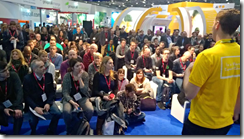 It has now been close to two weeks since the BETT show was hosted at the ExCeL in London. BETT is an exhibition aimed at helping schools develop their use of technology in the classroom. There are vendors and educationalists in the same building helping each other with their use of technology. I also enjoy the BETT show and I get to meet up with some amazing teachers and share success stories.
It has now been close to two weeks since the BETT show was hosted at the ExCeL in London. BETT is an exhibition aimed at helping schools develop their use of technology in the classroom. There are vendors and educationalists in the same building helping each other with their use of technology. I also enjoy the BETT show and I get to meet up with some amazing teachers and share success stories.
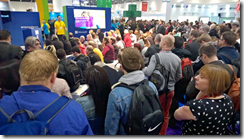 This year I was invited to the Microsoft Stand to share my use of Minecraft in the classroom. I had been struggling to teach some of the difficult content on the computing curriculum. I had a very dry approach to teaching logic gates which was not stimulating. It was during one lesson that a student mentioned “You mean like Minecraft”. It was this that made me start researching how I could use it in the classroom. Many of the students were already using it and it was very gender neutral.
This year I was invited to the Microsoft Stand to share my use of Minecraft in the classroom. I had been struggling to teach some of the difficult content on the computing curriculum. I had a very dry approach to teaching logic gates which was not stimulating. It was during one lesson that a student mentioned “You mean like Minecraft”. It was this that made me start researching how I could use it in the classroom. Many of the students were already using it and it was very gender neutral.
While at the show I was very shocked at the interest of Minecraft. It was a little overwhelming. You can see from the pictures that there was a lot of interest in how it could be used. The aim of this blog post is to answer some of the questions about the current availability and how you can set it up in your classroom. Some people also asked me to share some of my presentation online.
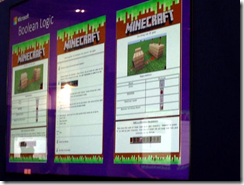 The very first thing I talked about was about how you can use Minecraft to teach students about logic gates using red stone. Not only can you logic gates, but you can also use it to teach programming. There is a useful programming mod which allows you to program. It’s called computercraft. I’m going to explain how you can set this up later on in the blog post.
The very first thing I talked about was about how you can use Minecraft to teach students about logic gates using red stone. Not only can you logic gates, but you can also use it to teach programming. There is a useful programming mod which allows you to program. It’s called computercraft. I’m going to explain how you can set this up later on in the blog post.
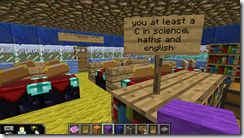 After talking to people about Minecrafts Education use in the computing curriculum, I explained about how useful it can be for other parts of the curriculum. I shared a number of different ways that Minecraft can be used for collaborative projects. In History you can use it to build trenches or you can set up war scenes and get the students to re-enact what the conditions might have been like.
After talking to people about Minecrafts Education use in the computing curriculum, I explained about how useful it can be for other parts of the curriculum. I shared a number of different ways that Minecraft can be used for collaborative projects. In History you can use it to build trenches or you can set up war scenes and get the students to re-enact what the conditions might have been like.
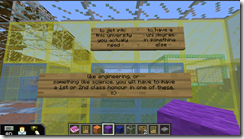 We recently used it in a careers lesson to get the students to thinking about the requirements for entering their favourite university. Our year 9 students are currently looking at options and we want to help them think about the G.C.S.E’s they will be taking.
We recently used it in a careers lesson to get the students to thinking about the requirements for entering their favourite university. Our year 9 students are currently looking at options and we want to help them think about the G.C.S.E’s they will be taking.
With the popularity of Minecraft in the classroom I have decided to write this blog to help you get set up!
Setting up Minecraft In your Classroom
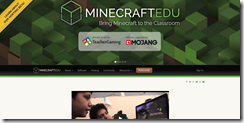 So the big question at BETT was “How can I get Minecraft?”. Many teachers were worried about the safeguarding issues, and so they should be. Minecraft does allow you to type in server I.P addresses so that you can connect to other worlds. To get around this issue we managed to find a website called MinecraftEdu. We were worried when we first signed up to this website. A few people had said that they hadn’t heard from them. You may take a week to hear back after your initial order. This is because they need to verify that you are infact an educational establishment.
So the big question at BETT was “How can I get Minecraft?”. Many teachers were worried about the safeguarding issues, and so they should be. Minecraft does allow you to type in server I.P addresses so that you can connect to other worlds. To get around this issue we managed to find a website called MinecraftEdu. We were worried when we first signed up to this website. A few people had said that they hadn’t heard from them. You may take a week to hear back after your initial order. This is because they need to verify that you are infact an educational establishment.
Upon setting up an account, I purchase 1 server ($41) and then I purchased 32 accounts ($14 each) – You get a reduced rate due to the accounts being purchased in bulk. Now it’s important that you know that the accounts that you’re given are not the MineCraft accounts specific from Mojang these are licenses to use in school. At least I believe them to be that…
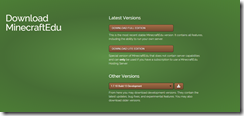 Once you have set up your accounts, you will be emailed a username and password. You can log in and you download the full edition. You will not need any of the other editions for your classroom at this point in time. When you run the set up file, you’ll be able to chose whether you want the server or not.
Once you have set up your accounts, you will be emailed a username and password. You can log in and you download the full edition. You will not need any of the other editions for your classroom at this point in time. When you run the set up file, you’ll be able to chose whether you want the server or not.
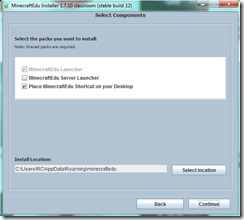 There are two types of setup. The picture on the left shows what the setup should look like for a computer without a server on it. You do not want to tick the box when installing it on the other machines in the classroom. These will be your clients and they will connect to your computer (the server). Now when I say server, I’m not talking about a big black box… I’ll explain more in a minute. You will need to tick the middle box, when installing Minecraft on your teacher machine. This will give you all of the controls.
There are two types of setup. The picture on the left shows what the setup should look like for a computer without a server on it. You do not want to tick the box when installing it on the other machines in the classroom. These will be your clients and they will connect to your computer (the server). Now when I say server, I’m not talking about a big black box… I’ll explain more in a minute. You will need to tick the middle box, when installing Minecraft on your teacher machine. This will give you all of the controls.
Running MinecraftEDU
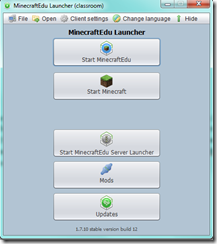 As soon as you open up MinecraftEDU you’ll notice two options. Start Minecraft (This is regular Minecraft). Do not worry about this option if you have filters such as SmoothWall in your school. This blocks our traffic and they cannot log into their own accounts. This means that they are forced to use the MinecraftEDU login.
As soon as you open up MinecraftEDU you’ll notice two options. Start Minecraft (This is regular Minecraft). Do not worry about this option if you have filters such as SmoothWall in your school. This blocks our traffic and they cannot log into their own accounts. This means that they are forced to use the MinecraftEDU login.
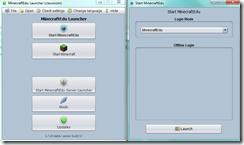 This will give them a window like this. They’re able to use the drop down menu but it won’t do too much for them. They don’t have Minecraft Hosting account and they certainly won’t be able to access their own Minecraft accounts due to filters in your school. I’m assuming you’ll have filters, if not speak to the technicians about blocking the specific Minecraft website. Click on the Launch Button to start Minecrafting!
This will give them a window like this. They’re able to use the drop down menu but it won’t do too much for them. They don’t have Minecraft Hosting account and they certainly won’t be able to access their own Minecraft accounts due to filters in your school. I’m assuming you’ll have filters, if not speak to the technicians about blocking the specific Minecraft website. Click on the Launch Button to start Minecrafting!
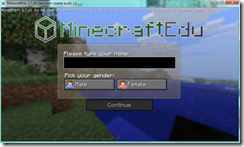 They will have the opportunity to pick their own alias and login. If they click on single player, this will mean that they can work on their own and they can start to build the world of their dreams. They can choose their settings. More of the controls and help files can be found on this blog entry here. This means that they can start playing and building.
They will have the opportunity to pick their own alias and login. If they click on single player, this will mean that they can work on their own and they can start to build the world of their dreams. They can choose their settings. More of the controls and help files can be found on this blog entry here. This means that they can start playing and building.
So how do my students collaborate and work together?
 On the teacher machine, you may remember that we set up a server? We installed a server which allows us to control the environment. When you click on this button from the launcher screen, it will allow you to set up the initial server where students can work. You will need to set a teacher password this is to stop students from having control when they’re in the Minecraft world.
On the teacher machine, you may remember that we set up a server? We installed a server which allows us to control the environment. When you click on this button from the launcher screen, it will allow you to set up the initial server where students can work. You will need to set a teacher password this is to stop students from having control when they’re in the Minecraft world.
 Click on this button and it will start up a server settings for you. You’ll have the option to pick the screen settings which can be shown on the next page. I usually allow animals and structures so that the students can extend on existing environments. The great things about the world they create is that it is stored on your computer. You can always revisit it.
Click on this button and it will start up a server settings for you. You’ll have the option to pick the screen settings which can be shown on the next page. I usually allow animals and structures so that the students can extend on existing environments. The great things about the world they create is that it is stored on your computer. You can always revisit it.
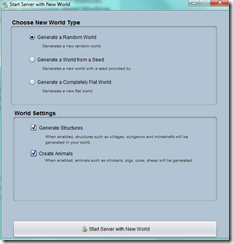 This is the settings menu which you can change before you start up your server.
This is the settings menu which you can change before you start up your server.
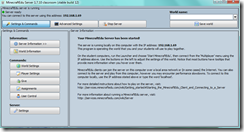 Your server is now running on your teacher machine. This means that you can start changing the world settings. This is the initial front screen. Some of the screen which might interest you are the player settings and the world settings. In the player settings you can choose whether you’re able to give students TNT and fire power. I turn this off when I’m doing projects. I also change the game mode to creative so that they can’t die. It allows them to just build and work together.
Your server is now running on your teacher machine. This means that you can start changing the world settings. This is the initial front screen. Some of the screen which might interest you are the player settings and the world settings. In the player settings you can choose whether you’re able to give students TNT and fire power. I turn this off when I’m doing projects. I also change the game mode to creative so that they can’t die. It allows them to just build and work together.
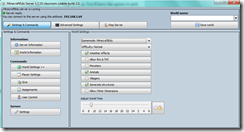 This example shows you some of the world settings that you can change. You’ll notice the setting at the top is what controls the overall experience. You can include other villagers, maybe you want to use the Minecraft world for story telling, you might want to use it as a starting point for a conversation.
This example shows you some of the world settings that you can change. You’ll notice the setting at the top is what controls the overall experience. You can include other villagers, maybe you want to use the Minecraft world for story telling, you might want to use it as a starting point for a conversation.
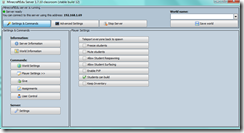 This example shows you some of the player settings you might want to control. I know that if I’m talking, I’ll want to freeze the students machines so that they’re listening to me instead of playing. This is when I would tick the Freeze button. It’s quite useful for that ‘STOP AND INTERJECT’ moment in lessons.
This example shows you some of the player settings you might want to control. I know that if I’m talking, I’ll want to freeze the students machines so that they’re listening to me instead of playing. This is when I would tick the Freeze button. It’s quite useful for that ‘STOP AND INTERJECT’ moment in lessons.
How do I connect to the server?
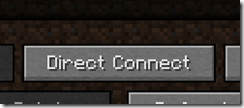 You’ll notice in the top left corner of the screen an I.P address. For the purpose of this document it’s just my local I.P address. Take note of the I.P address you’ll have and write it on the board for your students. When they log into Minecraft they’ll need to click on Multiplayer. They can click on direct connect and then they will need to type in the I.P address of the class. In some cases the I.P address is already there for my students. It might be the case for you.
You’ll notice in the top left corner of the screen an I.P address. For the purpose of this document it’s just my local I.P address. Take note of the I.P address you’ll have and write it on the board for your students. When they log into Minecraft they’ll need to click on Multiplayer. They can click on direct connect and then they will need to type in the I.P address of the class. In some cases the I.P address is already there for my students. It might be the case for you.
 Once you have included the I.P address, you will need to click on Join Server. This will allow you to connect with the teacher machine and other students in the classroom. You can have up to 100 people in a Minecraft Server. You could do a project across classrooms, just remember that it might be more difficult to manage if you have more people in your server.
Once you have included the I.P address, you will need to click on Join Server. This will allow you to connect with the teacher machine and other students in the classroom. You can have up to 100 people in a Minecraft Server. You could do a project across classrooms, just remember that it might be more difficult to manage if you have more people in your server.
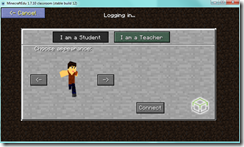 When staff or students log in to the server, they will be asked if they’re going to be the teacher or the student. The student will pick what their character looks like and will connect. The teacher will need to type in the password they used earlier. This will make sure that students don’t have control over any other character in the world.
When staff or students log in to the server, they will be asked if they’re going to be the teacher or the student. The student will pick what their character looks like and will connect. The teacher will need to type in the password they used earlier. This will make sure that students don’t have control over any other character in the world.
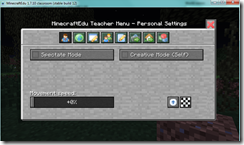 As a teacher, you can have control while you’re in the world. If you press the M button on your keyboard you have the settings screen. You can have all the control you would have over the server but you can remain invisible. A feature that I like is that you can untick a students number if they destroy something. This means they can still stay a part of the world but they cannot build or destroy blocks.
As a teacher, you can have control while you’re in the world. If you press the M button on your keyboard you have the settings screen. You can have all the control you would have over the server but you can remain invisible. A feature that I like is that you can untick a students number if they destroy something. This means they can still stay a part of the world but they cannot build or destroy blocks.
I hope that has been a useful start to using Minecraft in the classroom with Minecraft Edu, it shows you some of the features and you can make up your mind about how you would like to approach it in your classroom.
